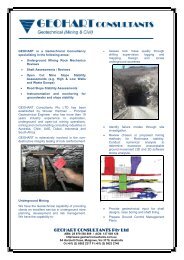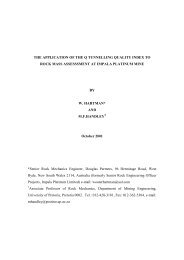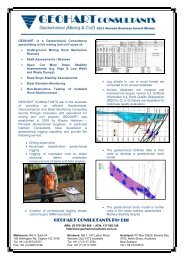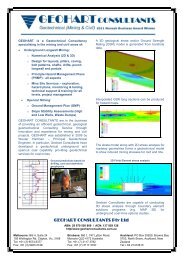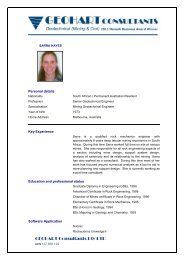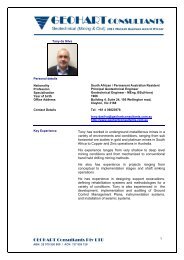Managing Geotechnical Risk through Non-Destructive Rock ...
Managing Geotechnical Risk through Non-Destructive Rock ...
Managing Geotechnical Risk through Non-Destructive Rock ...
You also want an ePaper? Increase the reach of your titles
YUMPU automatically turns print PDFs into web optimized ePapers that Google loves.
(i.e. bolt necking, bolt volume reduction <strong>through</strong> corrosion, bolt shearing (Hartman, 2003) and/or<br />
ineffective grout or resin embedment) or reflection point can be detected during testing.<br />
Figure 11 above shows some similarity to the load vs dissipation rate graph of a fairly recent (2004)<br />
collaborative investigation into the behaviour of cable bolts between the University of<br />
Saskatchewan, Saskatoon; Itasca Consulting Group, Inc., Minneapolis; University of British<br />
Columbia, Vancouver (BC) and the US National Institute of Safety and Health (NIOSH), which<br />
provided valuable information regarding their loading and strain behaviour.<br />
An article by Martin et al (2004) showed that a critical load is required before the cable bolt, at a<br />
given location, sense any load. This was done <strong>through</strong> instrumented cable bolts loaded at the collar<br />
and plotted against recorded microstrain at individual gauge locations (see below in Figure 12 the<br />
load profile along the length of the cable at different collar loads). This implied that a gauge<br />
positioned 25.4 cm from the collar will sense load only when the collar load exceeds 25.4 × 2,043<br />
N/cm.<br />
The above phenomenon however would need to be confirmed with some instrumented bolts.<br />
The test results obtained from the calibration tests are provided in Table 8 below and discussed<br />
further.<br />
One of the vital pieces of information obtained from the non-destructive test is the “Head Stiffness”<br />
as this is the basis of all the load predictions and it also indicates the serviceability of the total bolt<br />
system. The head stiffness is the “E” prime of the bolt, measured as a direct measurement of the<br />
first part of the “structural stiffness plot”, and is similar to a load/displacement graph for a pull out<br />
test.<br />
The “bolt head stiffness (tonnes/mm)” is compared to the two model stiffness values “E” min and<br />
“E” max. “E” min is a bolt model with the bolt pinned at its toe (end anchored) but with no<br />
clamping (no resin or grouting) along its length. “E” max is a bolt model with an infinite rigid base<br />
and “clamped” (full column grouted / resin) along its length. These models are based on the work<br />
carried out by Davis & Dunn (1974).<br />
The “Stiffness” value of the bolt is a good indicator of the serviceability of the bolt, but cannot be<br />
used in its entirety to give a serviceability rating for the bolt, as a number of factors come into affect<br />
when measuring the stiffness. The measurement of the stiffness can be affected by the fixity of the<br />
end of the bolt, the bonding effect of the resin/grout around the bolt and the bond from the rock to<br />
the resin/grout to ensure a fully encapsulated scenario of the bolt.<br />
11



